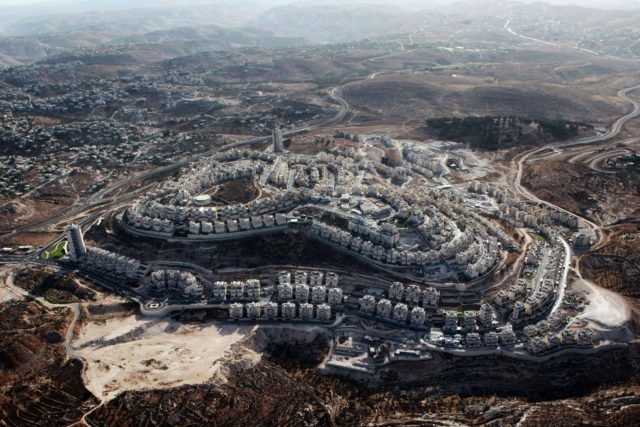Israeli settlements are the centerpiece of the Israeli occupation and are widely considered the biggest obstacle to achieving a just peace between Israelis and Palestinians. From the settlements spring a myriad of justice issues, due to the diverse and severe violations of Palestinian rights that Israel’s settlement enterprise causes.
At the time of the Oslo Accords in the 1990’s, there were already over 250,000 settlers in the occupied territories. Today that number has increased to 650,000 or more. In 2016, Israeli announced several plans for new settlements and numerous additions to existing settlements.
This ever expanding settlement enterprise is a glaring, continual violation of the principles and objectives of the so-called “peace process” in which Israel has participated for decades, something that the world powers that facilitate the peace process have largely ignored or protested with statements that are not enforced with effective actions at their disposal.
What are the settlements?
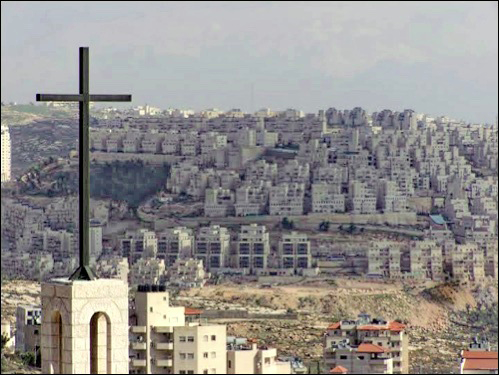
Israeli settlements are segregated communities only for Israeli Jews that have been created illegally in the occupied Palestinian territories. After it occupied the West Bank and Gaza (among other areas) in 1967, within one year Israel began to illegally colonize the occupied territory in violation of international law. Such law applies equally to East Jerusalem which – although Israel unilaterally expanded Jerusalem’s borders in 1967 and subsequently annexed the expanded municipality to itself – is occupied territory under international law and therefore barred from colonization.
Where are the settlers?
In the fifty years since this illegal Israeli colonization began, the settlements have spread through the West Bank. There are 125 or more recognized settlements, as well as 100 or more outposts. Outposts are fledgling settlements set up without Israeli government authorization but often with the aid and support of government officials. Outposts may achieve official government approval eventually and can grow into well-established communities.
There are several Jewish settler communities inside the Palestinian city of Hebron, and Israel is also placing settler communities in the midst of Palestinian neighborhoods in East Jerusalem proper. Israel also annexed to itself twelve Palestinian neighborhoods in the West Bank when it expanded the municipal borders of Jerusalem in 1967.
Previously, there were 16 settlements in the Gaza Strip and four in the northern West Bank that were dismantled in 2005. However, as with all of the West Bank, Gaza is still to be considered occupied territory under international law, for Israel controls the lives of all Gazans with its blockade by air, sea and land.
Settlements range from farming communities and frontier villages to urban suburbs and neighborhoods. Some can be considered cities, having tens of thousands of residents. Israel provides considerable incentives to move to the settlements, with generous subsidies for housing purchases, wide-ranging education benefits, grants and subsidies for industry and agriculture, taxes that are lower than within Israel, and more.
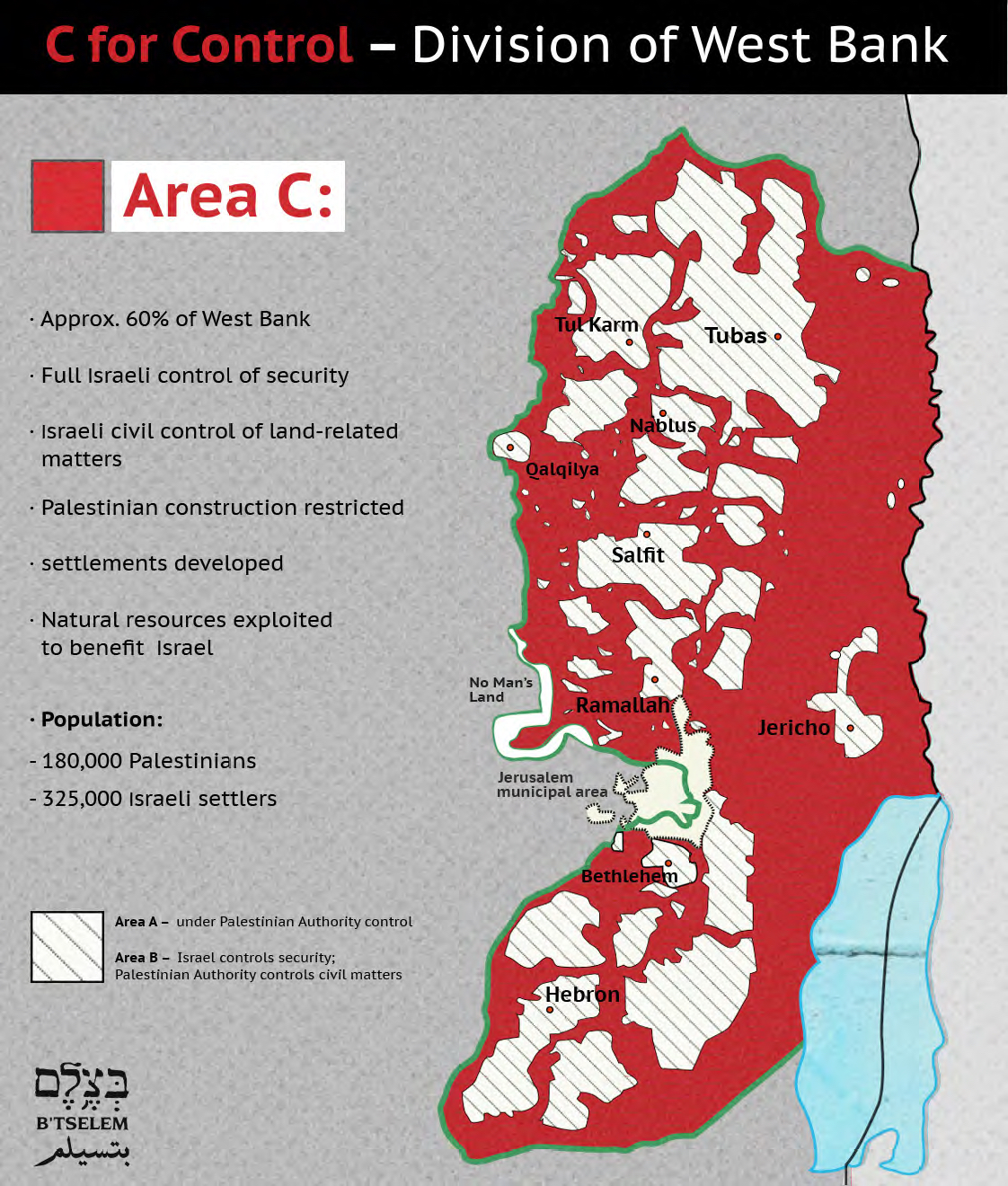 Today 60% or more of the West Bank is controlled by Israel; the settlement enterprise and the entire infrastructure that accompanies it have cut up the West Bank and created isolated cantons or bantustans for the Palestinians.
Today 60% or more of the West Bank is controlled by Israel; the settlement enterprise and the entire infrastructure that accompanies it have cut up the West Bank and created isolated cantons or bantustans for the Palestinians.
How do the settlements affect Palestinians?
As an occupying power, international law holds Israel responsible for the welfare of all the people in the occupied territory. Far from fulfilling its legal and moral obligations, Israel’s settlement enterprise causes systemic violations of Palestinians’ rights and has created a miserable existence for those living with its effects:
- Confiscating large swaths of land for the settlements, buffer zones, the Separation Wall, the segregated highway system, military zones, and more;
- Prohibiting housing expansion necessary for a growing population as well as infrastructure repair and other vital development of Palestinian communities;
- Destroying tens of thousands of Palestinian homes, over one million olive trees, and huge acreage of Palestinian agricultural land;
- Severely depriving Palestinians of adequate water, while allowing unlimited use of water by settlers, demolishing Palestinian wells and cisterns, and charging the Palestinians exorbitant water prices that are not applied to the settlers.
- Applying two legal and justice systems in the West Bank, according to an individual’s national identity: for the Palestinians, military law and courts that severely violate their rights; for the settlers, Israeli law that is based on democratic values;
- Exploiting Palestinian land, natural resources and workers for businesses in settlement industrial parks that export their products around the world, often labeled as “Made in Israel;”
- Denying Palestinians the essential freedom of movement within the occupied territory, through the use of hundreds of roadblocks and checkpoints, the Separation Wall and other means, thereby preventing ready access to jobs, education, hospitals, family members and more;
- Permitting frequent vigilante violence against Palestinians committed by settlers with protection from the Israeli military; and
- Creating widespread unemployment and smothering the development of the Palestinian economy, through the matrix of control mechanisms that apply to all aspects of life for Palestinians.
International Law and the Settlements
Through all these facets of the settlement enterprise, Israel has shown its disregard for international law for 50 years as of 2017. Its colonization of occupied Palestinian territories violates various instruments of international law by which it is bound, including the Hague Convention, the Fourth Geneva Convention, UN Security Council Resolutions 242, 465, and 2334, and the 2004 ruling of the International Court of Justice.
See more about Israeli policies and International Law here.
U.S. Policy Regarding the Settlements
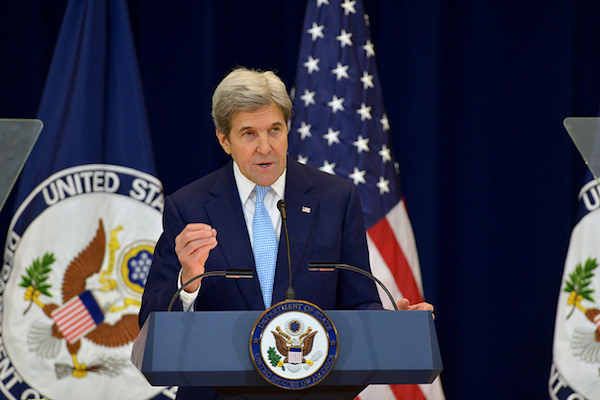
In December 2016, U.S. Secretary of State John Kerry, speaking on UN Security Council Resolution 2334, stated:
“It’s important to note that every United States administration, Republican and Democratic, has opposed settlements as contrary to the prospects for peace. And action at the U.N. Security Council is far from unprecedented. In fact, previous administrations of both political parties have allowed resolutions that were critical of Israel to pass, including on settlements.”
In fact the United States, Israel’s greatest ally, has consistently maintained not only that the settlements obstruct peace, but that they are prohibited by international law and by the peace agreements and processes that Israel is party to. It is the United States’ unswerving policy that all settlement expansion, whether for “natural growth” or new development, must cease. [In our Resources below, see CMEP’s collections of statements about the settlements by U.S. officials from the Obama administration back to the Johnson administration in the 1960’s.]
Resources
See also resources on The Occupation, many of which include information about the settlements.
PRINT & WEBSITE RESOURCES
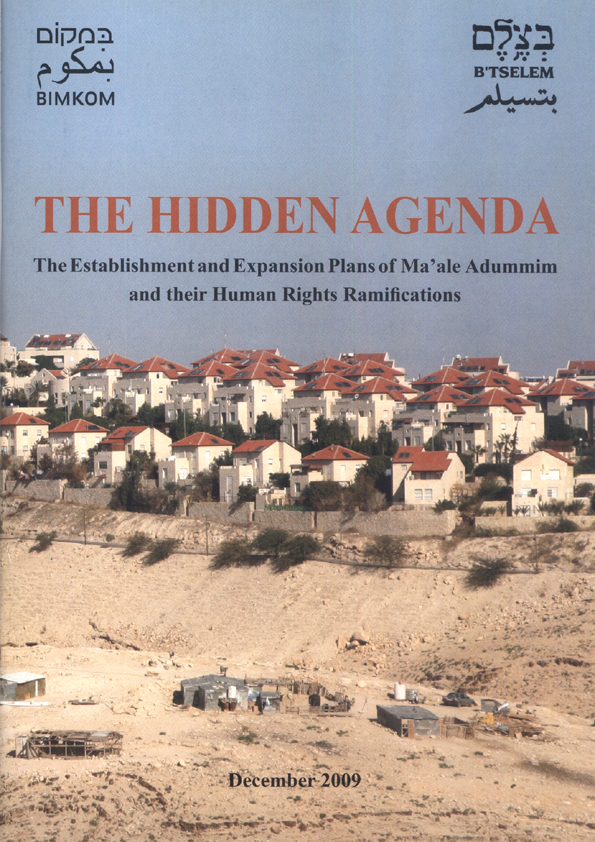 AFSC – Web page: Israel’s Settlement Policy in the occupied Palestinian territory (2013)
AFSC – Web page: Israel’s Settlement Policy in the occupied Palestinian territory (2013)
APN – Web page: Settlements 101 (2012)
B’Tselem – PDF: Hidden Agenda: The Establishment and Expansion Plans of Ma’ale Adumim and their Human Rights Ramifications (2009) – 59 pp.
B’Tselem – PDF: The Settlements and International Law (a portion of “Hidden Agenda” – see above) – 2 pp.
B’Tselem – Web page: By Hook and By Crook: Israeli Settlement Policy in the West Bank – Summary (2010)
B’Tselem – PDF: By Hook and By Crook – Full Report – 71 pp.
B’Tselem – Web page: Encouragement of migration to the settlements (2010)
B’Tselem – Web page: Land Expropriation and Settlements (2015)
B’Tselem – Web page: Statistics on Settlements and Settler Population (2015)
See in the right hand column of that page, an Excel spreadsheet: Settlements population
CMEP – PDF: US Officials’ Statements Concerning Settlements (2011) – 20 pp.
CMEP – Web page: a shorter version of US Officials’ statements
EAPPI – PDF: Living with Settlers (2011) – 71 pp.
EAPPI – PDF: An Unjust Settlement (2010) – 100 pp.
FMEP – Web page: Weekly Settlement Reports (ongoing)
FMEP – Web page: East Jerusalem Settlements Statistics (2011)
FMEP – PDF: Israeli Settler Population 1972-2006
NAD – Web page: Fact Sheet: The Israeli Government’s Unbreakable Commitment to the Israeli Settlement Enterprise (2013) – 3 pp.
NAD – PDF: The Settlement of Gilo: An Internationally Recognized War Crime (2013) – 4 pp.
UCCanada – Web page: What Are Israeli Settlements? (2013)
UCCanada – Web page: How Do the Settlements Affect Palestinians? (2013)
 UMKR – PDF: The Settlements: Colonizing the Land, Destroying Lives (2012) – 4 pp.
UMKR – PDF: The Settlements: Colonizing the Land, Destroying Lives (2012) – 4 pp.
VIDEO
AFSC – Video: Illegal Israeli Settlements and Palestine: A Land In Fragments – 2 mins.




